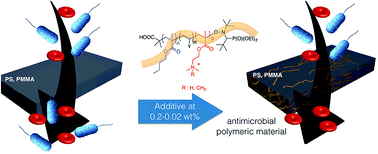Elaboration of antimicrobial polymeric materials by dispersion of well-defined amphiphilic methacrylic SG1-based copolymers
Abstract
Bacterial resistance to antibiotics is a major public health problem and there is an urgent need to find new antimicrobial materials to circumvent the development of resistant pathogens. The aim of this work is to propose an efficient and versatile method for the elaboration of antimicrobial polymeric materials based on the simple dispersion of a low amount of high molecular weight (Mn > 20 000 g mol−1) amphiphilic methacrylic copolymers prepared by nitroxide-mediated polymerization in different common organic matrices (here PS and PMMA). More precisely, after studying the influence of different copolymer parameters on their biological activity (the amount and type of comonomer (styrene or acrylonitrile), the architecture (random or diblock), and the type of cationic charge (permanent or not)), some selected candidates were dispersed in PS and PMMA matrices and were shown to efficiently turn these inactive materials into antibacterial ones without a significant hemolytic character. In particular, only 0.02 wt% of antimicrobial copolymers were sufficient to confer an activity against both Gram positive (B. subtilis) and Gram negative (E. coli) bacteria.



 Please wait while we load your content...
Please wait while we load your content...